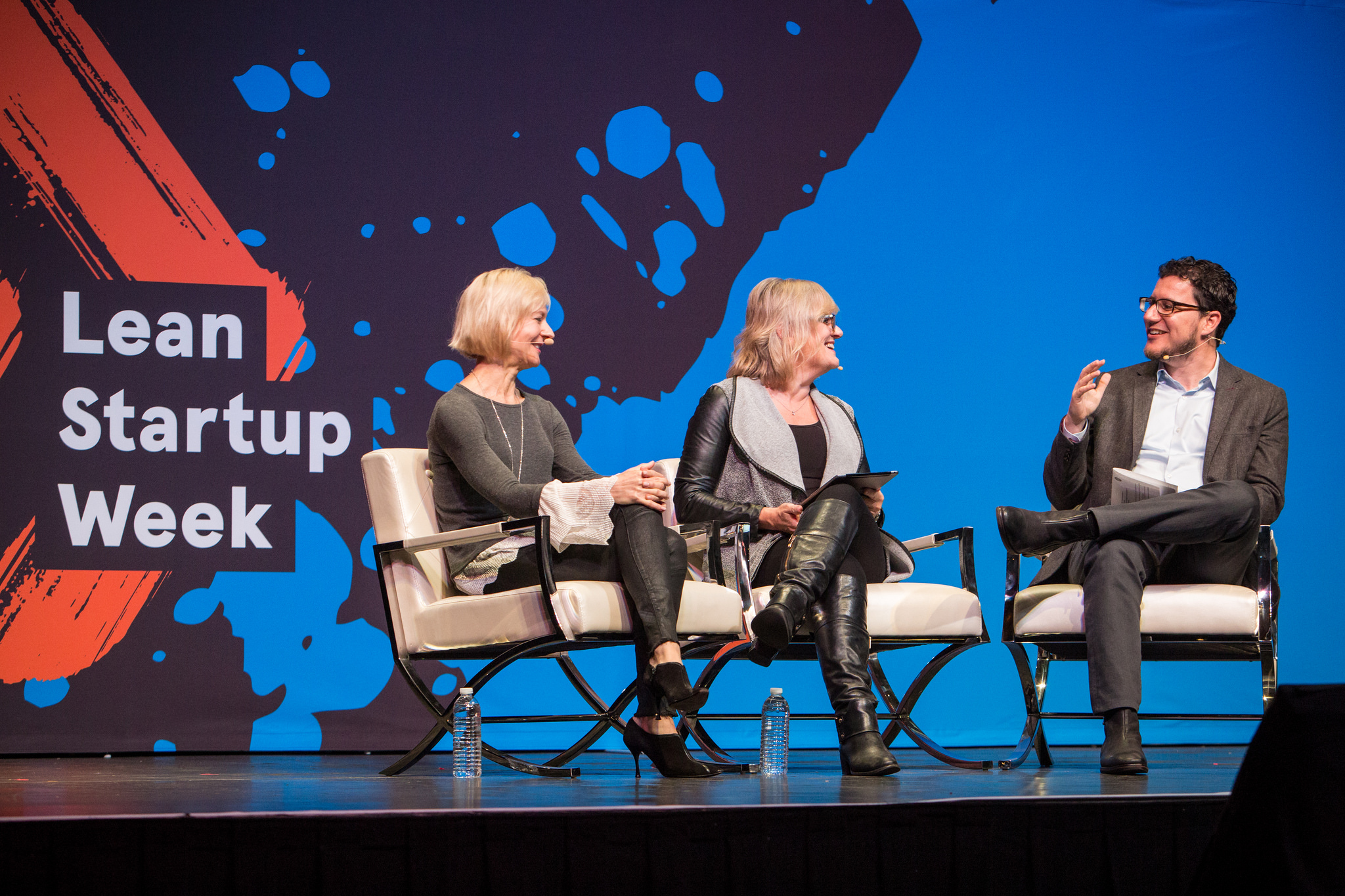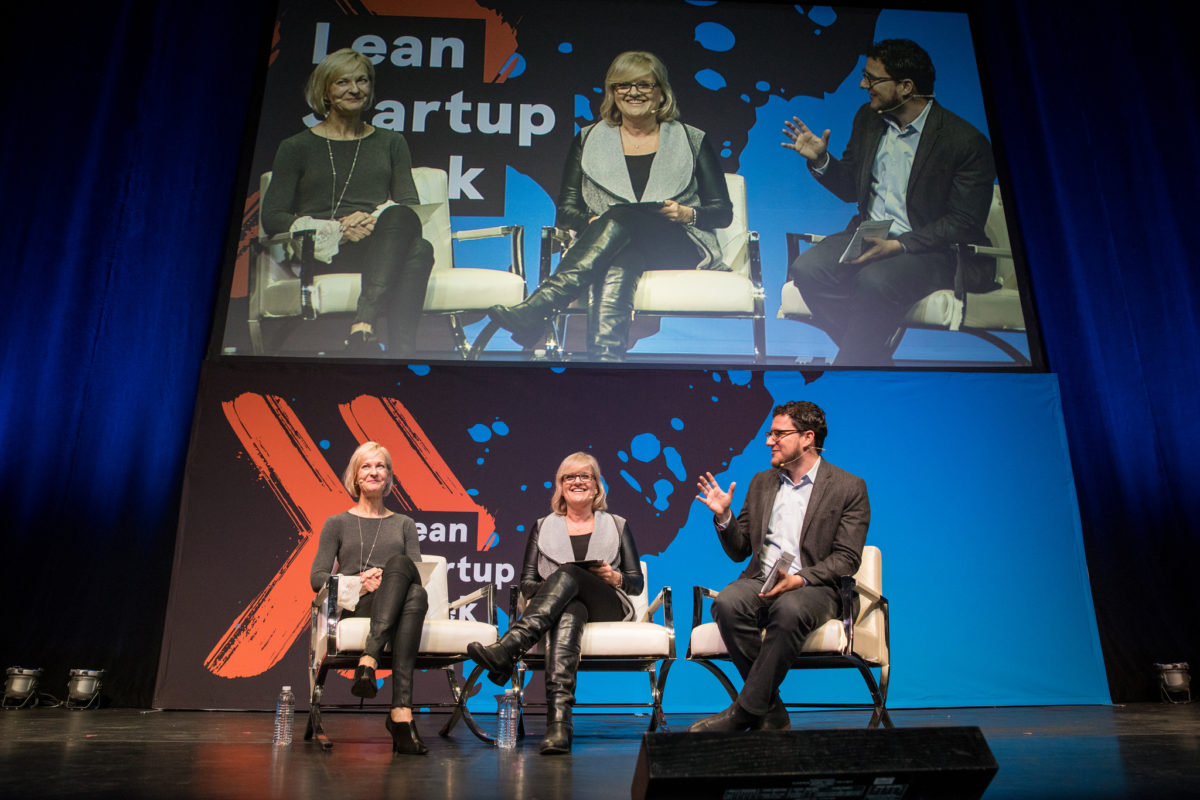FastWorks: Reflecting on its Origin and Evolution

In a recent fireside chat, Eric Ries sat down with Viv Goldstein and Janice Semper to discuss FastWorks, the innovation platform they co-founded at GE. What followed was a compelling and insightful conversation about their journey scaling entrepreneurial tools, processes and culture across GE.
Viv and Janice had already been working at GE for several decades in 2012 when CEO at the time, Jeffrey Immelt, wanted to find ways to bring more new products to market faster and solve more of their customers’ “really gritty problems,” Viv said. This coincided with the release of Eric’s book The Lean Startup.
Viv recalls attending a book signing of Eric’s and being blown away by the concept. “Beth Comstock and I sat in the audience and we went ‘Oh my god, This is it. This is amazing. How can we test that and start to think in a very different way?” She credits this as, essentially, the birth of FastWorks.
“Beth Comstock and I sat in the audience and we went ‘Oh my god, This is it. This is amazing. How can we test that and start to think in a very different way?” -@vivgoldstein on attending @ericries' book signing. Click To TweetDon’t Be Thwarted by Failure
They realized that in order to introduce these concepts they’d have to focus their efforts, so they identified one project to work on, the Series X engine. Viv remembers a lot of “Doubting Thomases in the room.” People who didn’t understand how to apply the Lean method to products that GE makes, “like aircraft engines, MRIs and locomotives.”
Yet soon after partnering with Janice on the Series X engine, Viv said, “We started to see some real impact.” They rolled it out to a total of eight projects that were soon making huge progress over three months.
However, when they “cut the cord,” Janice said, letting these projects run on their own without supervision and coaching, they soon found their project leaders frustrated. “Every one of them was basically telling us a war story,” Janice said.
What they learned when they received feedback was that a lot of managers on the projects weren’t invested in the Lean methodology, telling their employees “Just get back to work. What’s an MVP? We can’t do minimum viable engines here,” Janice explained.
That’s when they realized, Janice said, “We have to fight for this because it’s the right thing to do for our employees and for the company and for our customers.”

Going Lean Can Mean a Culture Change
They quickly realized that getting everyone on board in GE required a culture change.
“You can’t do this one project team at a time. You’ve got to create a culture that can support this way of working,” Janice explained.
They had to step back and translate the language of Lean into GE’s lexicon.
What this meant practically was “meeting after meeting after meeting,” Janice said, with “hundreds and thousands of GE managers who ultimately became dedicated to this [process].”
Eric remembered a highlight when Mark Little, head of global research, finally realized that he was part of the problem in holding back progress. “I remember it as a lot of very painful conversations and meetings, just really having to plug away at it,” Eric said.
One of the changes Viv and Janice had to facilitate was to the performance management system, which was “out of sync” with Lean ways of working, Janice said.
When she brought that up, “People would just stare at me and not even know how to respond.”
With persistence, and solid data to back her up, she continued to chip away at leadership’s resistance until she finally broke through to the CEO who eventually told her to go ahead even though he didn’t fully understand how it would work.
“It was a huge moment for the company to look at a legacy sacred cow process that’s been held up as world class and say ‘We’re going to throw it out the window,” Janice said.
“It was a huge moment for the company to look at a legacy sacred cow process that’s been held up as world class and say ‘We’re going to throw it out the window.”
“It was a huge moment for the company to look at a legacy sacred cow process that’s been held up as world class and say ‘We’re going to throw it out the window.” -@janiceLsemper Click To TweetUnleashing Creative Energy
Getting rid of that “sacred cow” and implementing new, Lean, processes was worth all the hassle in getting there, Eric reassured. In fact, it unleashed a font of creativity in a bunch of employees. “We would see in these workshops…people would be in tears about finally having the opportunity to work in the way they’ve always wanted. And how many underground secret entrepreneurs [did] we discover who had been living in secret?”
Suddenly, people from other departments such as HR, legal and finance were coming up to them saying they wanted to act in a different way, to start thinking about the customer and the outcome, Viv said. “Employees were…begging for it.”
This inspired them to transform FastWorks for new product introduction to what they called FastWorks Everyday, bringing Lean to the entire company at all levels. Eric jumped in calling it “quite radical in its own way.”
They took the rigor and depth of FastWorks, which is “very data focused, about experimentation, metrics, innovation and accounting” according to Viv, and asked, “How can you take that down to its lowest common denominator?”
It boiled down to four essential concepts: Discover, develop, learn, and act. These four concepts can be applied to any product, and any department.
While they’ve had tremendous success with this approach, it has come with its share of “messiness,” Janice said. A necessary part of the process has been “constantly being uncomfortable” in order to allow for change. She emphasized, “This is not about a linear, change-controlled process.”
Taking Measure
Another big step in GE’s Lean transformation success was rethinking how they measure impact. They moved away from vanity metrics to tap deeper into how employees are feeling in order to inspire behavioral change that was key to the larger culture change.
Janice said this meant constantly looking at “our employees as our customer, our managers as customers, and our senior leaders, and saying ‘What are the problems and their pain points? What is success from their perspective?’”
When they were working on the internal design of the performance management system, for example, they found that employees and managers alike wanted the ability to get feedback from peers as well as managers.
So they created a tool called Support Central, a simple survey, and they trained 100 employees how to use the tool and asked them to do so over a two-week period.
The tool flopped: nobody used it. When they tried to discover why, they found out that people didn’t feel that they knew how to give feedback. “We discovered that the issue had nothing to do with the tool; it was all about…creating that environment, the high levels of trust for that to happen,” Janice explained.
She went on, “That was an important learning as we started to introduce what we now call performance developments. Our emphasis is much more on training around the behavior, and much less about the tool.”
If they hadn’t probed more deeply, she said, they would have wasted a lot of time and effort and learned nothing.
Anatomy of a Successful MVP
Toward the end of the chat, Eric posed a question that had come in from an audience member about a favorite success story.
Viv brought up an example from their Sustainable Healthcare Solutions business, which went through a challenging time selling a neonatal incubator in India, a small market that should have been fairly easy to reach.
Before Lean, Viv said, “technology used to be our lead” but now they’ve reframed that and start with the customer. After doing some deep customer ethnography they found out key details about how incubators are housed in India versus the US, Europe or China.
“In a rural clinic, they’re going to be stacked side by side, so the way the incubator opens is going to make a phenomenal difference,” Viv said.
Then, they learned that in countries with “almost infinite resources” you have one baby per incubator, but in a rural clinic in India, they often put two babies in one incubator. “So we had to create a heat source that dissipated the heat equally around the whole of the incubator,” she explained.
“This kind of very, very deep customer discovery helped us understand what were the needs of the market.”
Their first MVP was “a shoebox and a doll” which they took to clinics and watched midwives, nurses and doctors put the babies in and out of the “incubator.”
The level of experimentation got more sophisticated as they got to know their customer’s needs better but it went a long way toward the product’s success.
Get Your Hands Dirty
Making a Lean culture change ultimately comes down to “one person at a time,” Janice said. Individual conversations in which one person sees the value in it and “starts to bring others along with them.”
“When a person actually gets their hands dirty, they experience it, they feel the value and articulate the value. [That’s] when you start to see the change.”
But be patient. As Janice and Viv’s story reveals, it can take a lot of time, passion and persistence to bring a company on board.
Thank you to Jordan Rosenfeld for contributing this piece. If you seek to bring the entrepreneurial spirit to your organization, Lean Startup Co. can help.

